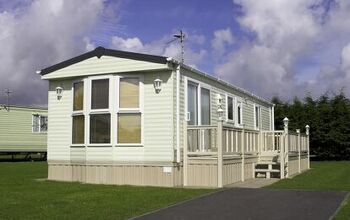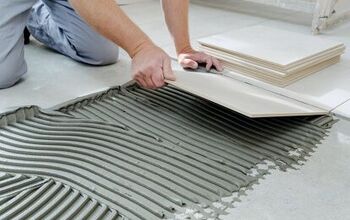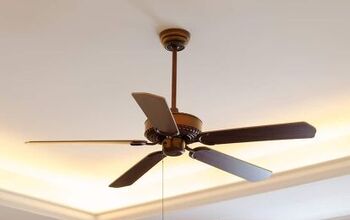Can You Raise The Ceiling In A Mobile Home?

Mobile homes can offer an affordable, customizable space that doesn’t have the same requirements and costs that a traditional home does. But there are times where changes need to be made and more space created.
Can you raise the ceiling on your mobile home? The short answer is yes. The process of raising the ceiling is about changing the pitch of the roof. Increasing the pitch offers many structural and aesthetic improvements that a flatter roof would not.
It can also give the aesthetic that there is far more space than there really is.
Do You Need Wall and Ceiling Contractors?
Get free, zero-commitment quotes from pro contractors near you.

Older Mobile Homes
Newer mobile homes are constructed differently, accounting for space limitations. They also make use of different materials than older homes. If you own a mobile home that is getting up there in age, there’s a good chance the room is aluminum and that it has a pretty low pitch.
This facilitates the need to replace the old aluminum roof. These roof styles will not only wear down over time, they can’t simply be raised up. They will need to be replaced entirely, which can help provide a new level of integrity and safety while at the same time providing a higher pitch.
When it comes to ceiling height, most older mobile homes have a standard of seven foot high ceilings. While this can offer a very cozy living space, it lends itself to major decor challenges. Whether your mobile home roof simply needs an update or you’re looking to expand the height of your ceilings, you can do this by increasing the roof pitch.
What is Roof Pitch?
The pitch of the roof is measuring the incline from the edges of the roof to the center point of the roof. Even if the mobile home is manufactured in a factory, it can have a different roof pitch than others of the same model.
Having a higher roof pitch can be more aesthetically appealing and make the home look more welcoming. It also provides better structural support for the rest of the mobile home. Changing the pitch is generally done to give the mobile home a traditional home look.
Increased pitch can offer better support in snow or heavy rain, which can potentially prevent water damage and leaks from occurring. Not only that, it can provide a greater overall strength and give greater longevity to the roof while requiring less maintenance.
| Roof Pitch | Roof Pitch Degrees |
| 1-12 | 4.76° |
| 2-12 | 9.46° |
| 3-12 | 14.04° |
| 4-12 | 18.43° |
| 5-12 | 22.62° |
| 6-12 | 26.57° |
| 7-12 | 30.26° |
| 8-12 | 33.69° |
| 9-12 | 36.87° |
| 10-12 | 39.81° |
| 11-12 | 42.51° |
| 12-12 | 45° |
Replacing the Roof or Working Over Top
The first decision that needs to be made is weather to install a new roof over the original or to completely replace the roof. Starting fresh may be the more costly option, but it offers a fresh start. No bring any structural damage or leaks over that may have existed in the previous roof.
Roofing over the previous roof will not eliminate any underlying issues. The only upside to laying the new roof over the old one is that it can be done on a tight budget and save on up-front costs. If there are issues with the old roof, those will eventually catch up and result in repairs down the line.
Check with the Local Government
Depending on the area that you live, increasing the pitch of your roof may require some permission. The last thing that anyone wants is to install the new roof only to find that it violates a local ordnance. When that happens, it can lead to fines or even the necessity of removing the new roof.
Also, make sure to keep weight in mind. Roofs are graded to have a specific load bearing capability. This allows for proper materials to be used so that the roof can stand up to the average amount of weight given the roof type and weather conditions. When in doubt, speak to a structural engineer who’ll be able to verify the safety of your new roof pitch.
What is in the Ceiling of a Mobile Home?
Generally speaking, mobile homes won’t have sheetrock ceilings. They will have tile or ceiling board that are somewhere between 1.5-4 feet wide and will often run the entire width of the mobile home.
There are also some different variations of ceiling tile that will be held up using rosettes and screws. These may potentially need to be replaced when installing a new roof over the top of the existing roofing structure.
Materials for Roofing
When building the new roof, there are generally three popular options for mobile homes: asphalt shingles, aluminum, and rubber membranes. Each offers its own set of benefits and downsides, so choose carefully based on need and budget.
Aluminum is easy to install and is structurally sound, but it is costly. Asphalt is cheap and offers a more traditional look to a mobile home but can have issues regarding leaking or any excess weight from heavy snows. Rubber membrane is in the middle for costs and can actually provide greater energy efficiency, but it may be the shortest of the lifespans.
The decision for which roof material to use on your mobile home should be based on your budget and other considerations like the general climate in your area. When the materials have been chosen, it is time to increase the pitch of the roof.
Step One: Repair Any Damages
If you plan to change the pitch of the existing roof and not start with a brand-new installation, the first step should be to fix any current issues. Not only will this extend the life of the roof, it will be easier to do than after the new roof is installed.
The underlying roof should be in the best shape possible before installing the new roof pitch. Ignoring current issues is a recipe for disaster and will eventually require repair or replacement depending on the severity of the current issues.
Step Two: Get a Roof Over Kit
It cannot be recommended enough that if you are trying to increase the pitch yourself that you get a roof over kit. These kits have all of the materials necessary to do the job, including trusses and/or frames depending on the kit that you purchase.
Even better, the kit that you purchase will have very specific instructions based on mobile home size, building material, and the angle of the new roof pitch. This can be extremely helpful for do-it-yourselfers who have not done any roofing work previous to this.
Step Three: Building the Frame and Adding the Trusses
This is where the bones of the structure will be installed. The frame for the new pitch (which can be calculated using helpful guides) needs to be constructed first, attaching to the underlying roof if you are going that route.
When the framing of the roof has been properly installed, it needs to be secured using the aforementioned trusses. The trusses are meant to provide structural support and integrity to the frame, allowing it to hold up under the weight of snow and debris throughout the year.
It is imperative that trusses be the proper size. This is where purchasing a kit is so helpful. Improperly fitted trusses can wear down faster and compromise the structural integrity of the entire roof.
Step Four: Lay Down the New Roofing Materials
The last step in the process is to then lay down the new materials. Before laying your materials down, make sure that any vent pipes extend through the new pitch and make sure to use flashing to seal it properly.
Carefully secure the new roofing materials down, making sure that there is even coverage throughout. Rushing through a job leaves uneven application and that is the quickest path to leaks and roof damage in a short period of time.
Do You Need Wall and Ceiling Contractors?
Get free, zero-commitment quotes from pro contractors near you.

How to Make Mobile Home Ceilings Appear Higher
If you’d rather not take on a major home improvement project, there are some design tricks that you can implement to make the low ceilings in your mobile home appear much higher than they actually are. Something as simple as well-placed artwork, a new coat of paint, or bigger doors, can make the rooms feel larger.
- Paint your ceilings a high gloss white. Experts suggest that applying a glossy paint to the ceilings offers a reflective sheen that makes the surface seem taller.
- Group your artwork. To add height to your rooms, install art, photos, and other wall décor in groups. Gallery walls that are arranged tall and narrow will help trick the eye.
- Add some mirrors. For centuries, mirrors have been used to make small spaces appear larger. Try adding some floor length mirrors to your mobile home.
- Switch up the lighting. A technique known as uplighting, can attract the eye. Use lamps or wall sconces and position the light upwards, toward the ceiling.
- Change the doors. Mobile homes often come standard with oddly sized doors that are much smaller than conventional interior doors. If you have the room for a wider and taller door, it can create the illusion that the space is larger and the ceilings are taller.
Whether you decide to change the pitch of your roof or implement some design tricks, there are ways to raise the ceiling in a mobile home.

Ryan Womeldorf has more than a decade of experience writing. He loves to blog about construction, plumbing, and other home topics. Ryan also loves hockey and a lifelong Buffalo sports fan.
More by Ryan Womeldorf



























